Afghan vs French Community Comparison
COMPARE
Afghan
French
Social Comparison
Social Comparison
Afghans
French
7,658
SOCIAL INDEX
74.1/ 100
SOCIAL RATING
108th/ 347
SOCIAL RANK
5,755
SOCIAL INDEX
55.1/ 100
SOCIAL RATING
169th/ 347
SOCIAL RANK
French Integration in Afghan Communities
The statistical analysis conducted on geographies consisting of 148,649,581 people shows a poor positive correlation between the proportion of French within Afghan communities in the United States with a correlation coefficient (R) of 0.187. On average, for every 1% (one percent) increase in Afghans within a typical geography, there is an increase of 0.066% in French. To illustrate, in a geography comprising of 100,000 individuals, a rise of 1,000 Afghans corresponds to an increase of 66.1 French.
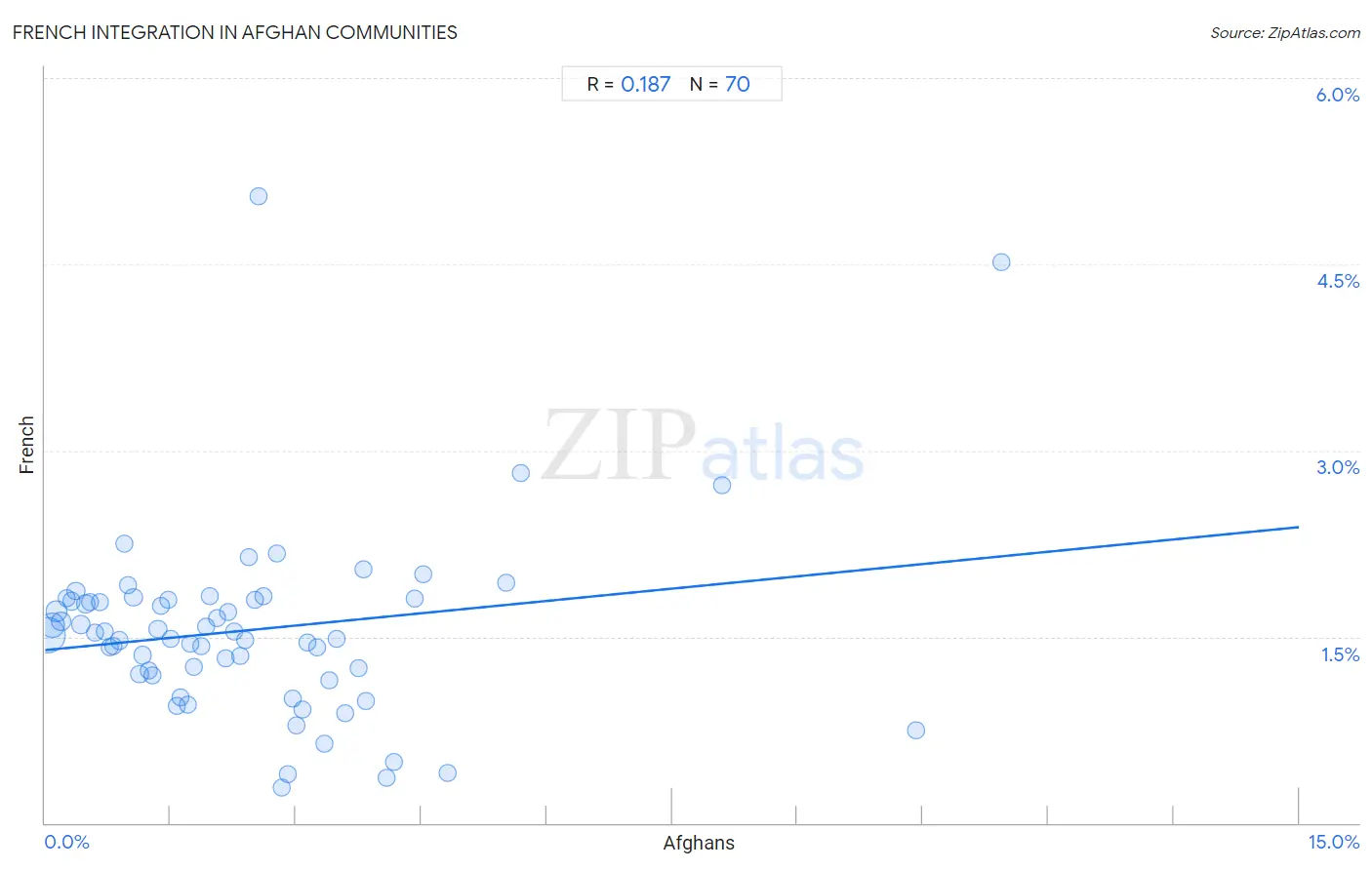
Afghan vs French Income
When considering income, the most significant differences between Afghan and French communities in the United States are seen in median household income ($97,026 compared to $83,468, a difference of 16.2%), householder income over 65 years ($68,951 compared to $59,656, a difference of 15.6%), and wage/income gap (24.9% compared to 28.7%, a difference of 15.1%). Conversely, both communities are more comparable in terms of per capita income ($46,268 compared to $43,685, a difference of 5.9%), median male earnings ($59,554 compared to $55,350, a difference of 7.6%), and median family income ($112,971 compared to $102,368, a difference of 10.4%).

| Income Metric | Afghan | French |
| Per Capita Income | Exceptional $46,268 | Average $43,685 |
| Median Family Income | Exceptional $112,971 | Average $102,368 |
| Median Household Income | Exceptional $97,026 | Fair $83,468 |
| Median Earnings | Exceptional $51,112 | Average $46,296 |
| Median Male Earnings | Exceptional $59,554 | Good $55,350 |
| Median Female Earnings | Exceptional $43,077 | Tragic $38,457 |
| Householder Age | Under 25 years | Exceptional $58,019 | Tragic $51,230 |
| Householder Age | 25 - 44 years | Exceptional $104,410 | Fair $93,665 |
| Householder Age | 45 - 64 years | Exceptional $112,676 | Average $99,824 |
| Householder Age | Over 65 years | Exceptional $68,951 | Fair $59,656 |
| Wage/Income Gap | Excellent 24.9% | Tragic 28.7% |
Afghan vs French Poverty
When considering poverty, the most significant differences between Afghan and French communities in the United States are seen in single male poverty (10.7% compared to 14.4%, a difference of 34.7%), single father poverty (14.0% compared to 18.2%, a difference of 30.3%), and married-couple family poverty (5.5% compared to 4.3%, a difference of 27.5%). Conversely, both communities are more comparable in terms of receiving food stamps (10.7% compared to 10.7%, a difference of 0.14%), seniors poverty over the age of 75 (11.2% compared to 11.1%, a difference of 0.79%), and female poverty (13.0% compared to 12.9%, a difference of 1.0%).
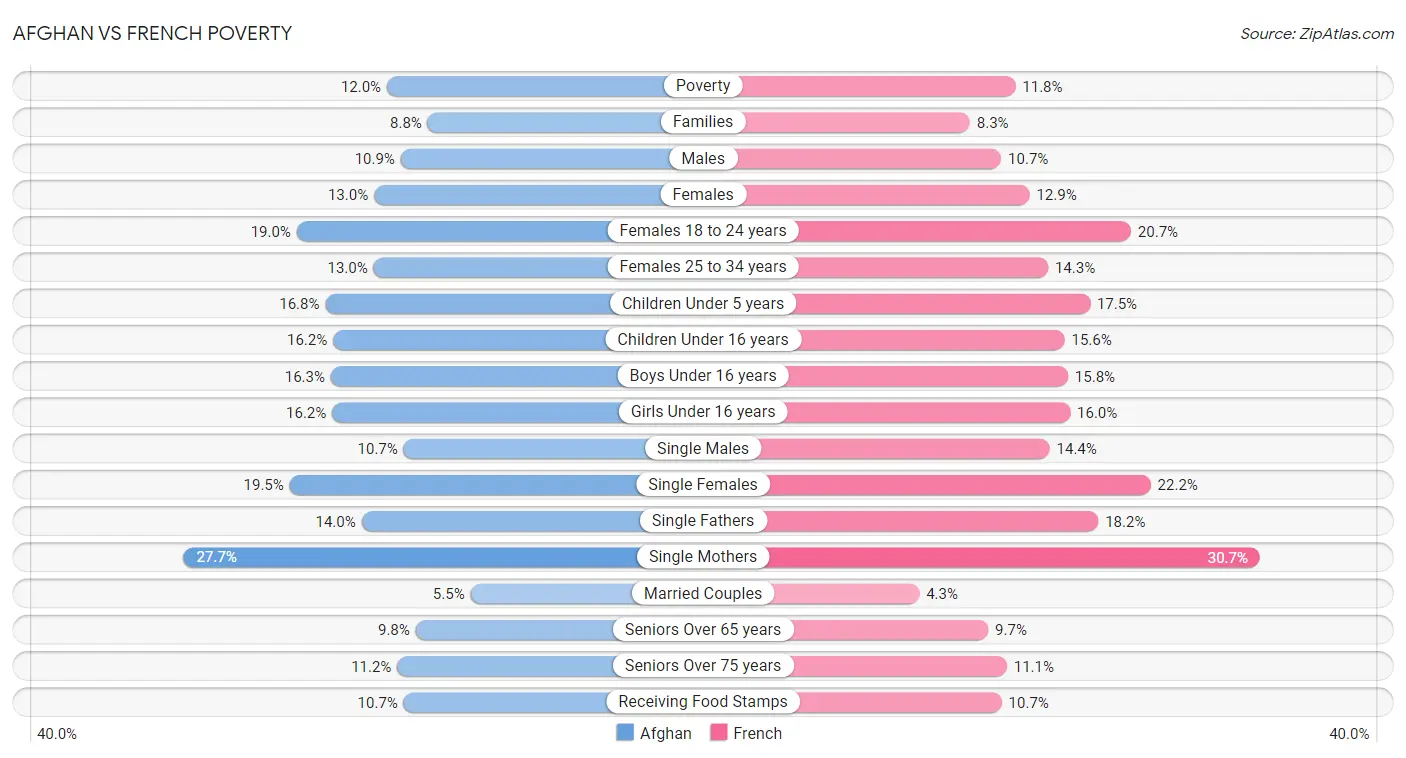
| Poverty Metric | Afghan | French |
| Poverty | Good 12.0% | Excellent 11.8% |
| Families | Good 8.8% | Exceptional 8.3% |
| Males | Good 10.9% | Excellent 10.7% |
| Females | Good 13.0% | Excellent 12.9% |
| Females 18 to 24 years | Exceptional 19.0% | Tragic 20.7% |
| Females 25 to 34 years | Excellent 13.0% | Tragic 14.3% |
| Children Under 5 years | Good 16.8% | Fair 17.5% |
| Children Under 16 years | Average 16.2% | Good 15.6% |
| Boys Under 16 years | Average 16.3% | Good 15.8% |
| Girls Under 16 years | Good 16.2% | Good 16.0% |
| Single Males | Exceptional 10.7% | Tragic 14.4% |
| Single Females | Exceptional 19.5% | Tragic 22.2% |
| Single Fathers | Exceptional 14.0% | Tragic 18.2% |
| Single Mothers | Exceptional 27.7% | Tragic 30.7% |
| Married Couples | Poor 5.5% | Exceptional 4.3% |
| Seniors Over 65 years | Exceptional 9.8% | Exceptional 9.7% |
| Seniors Over 75 years | Exceptional 11.2% | Exceptional 11.1% |
| Receiving Food Stamps | Exceptional 10.7% | Exceptional 10.7% |
Afghan vs French Unemployment
When considering unemployment, the most significant differences between Afghan and French communities in the United States are seen in unemployment among women with children ages 6 to 17 years (7.6% compared to 9.7%, a difference of 28.0%), unemployment among women with children under 6 years (7.0% compared to 8.2%, a difference of 16.6%), and unemployment among seniors over 75 years (9.0% compared to 10.3%, a difference of 13.8%). Conversely, both communities are more comparable in terms of unemployment among ages 55 to 59 years (4.7% compared to 4.7%, a difference of 0.17%), unemployment among ages 35 to 44 years (4.7% compared to 4.7%, a difference of 0.40%), and unemployment among youth under 25 years (11.3% compared to 11.2%, a difference of 1.4%).
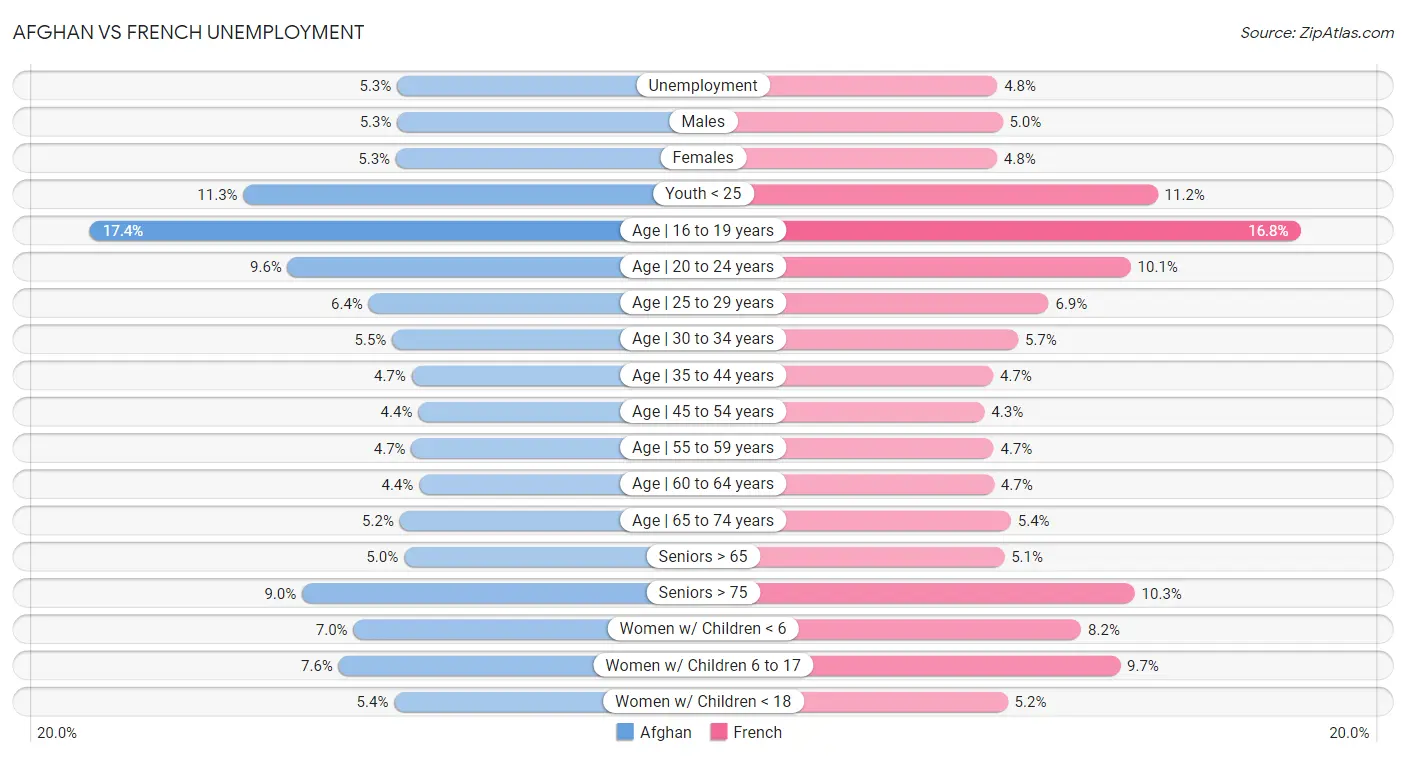
| Unemployment Metric | Afghan | French |
| Unemployment | Average 5.3% | Exceptional 4.8% |
| Males | Good 5.3% | Exceptional 5.0% |
| Females | Fair 5.3% | Exceptional 4.8% |
| Youth < 25 | Excellent 11.3% | Exceptional 11.2% |
| Age | 16 to 19 years | Good 17.4% | Exceptional 16.8% |
| Age | 20 to 24 years | Exceptional 9.6% | Excellent 10.1% |
| Age | 25 to 29 years | Exceptional 6.4% | Poor 6.9% |
| Age | 30 to 34 years | Average 5.5% | Poor 5.7% |
| Age | 35 to 44 years | Average 4.7% | Average 4.7% |
| Age | 45 to 54 years | Excellent 4.4% | Exceptional 4.3% |
| Age | 55 to 59 years | Exceptional 4.7% | Exceptional 4.7% |
| Age | 60 to 64 years | Exceptional 4.4% | Exceptional 4.7% |
| Age | 65 to 74 years | Exceptional 5.2% | Average 5.4% |
| Seniors > 65 | Exceptional 5.0% | Good 5.1% |
| Seniors > 75 | Tragic 9.0% | Tragic 10.3% |
| Women w/ Children < 6 | Exceptional 7.0% | Tragic 8.2% |
| Women w/ Children 6 to 17 | Exceptional 7.6% | Tragic 9.7% |
| Women w/ Children < 18 | Good 5.4% | Excellent 5.2% |
Afghan vs French Labor Participation
When considering labor participation, the most significant differences between Afghan and French communities in the United States are seen in in labor force | age 16-19 (36.1% compared to 42.1%, a difference of 16.7%), in labor force | age > 16 (67.1% compared to 63.9%, a difference of 5.0%), and in labor force | age 20-24 (75.2% compared to 77.4%, a difference of 2.9%). Conversely, both communities are more comparable in terms of in labor force | age 30-34 (84.7% compared to 84.4%, a difference of 0.36%), in labor force | age 25-29 (84.4% compared to 84.7%, a difference of 0.39%), and in labor force | age 35-44 (84.6% compared to 84.0%, a difference of 0.71%).

| Labor Participation Metric | Afghan | French |
| In Labor Force | Age > 16 | Exceptional 67.1% | Tragic 63.9% |
| In Labor Force | Age 20-64 | Exceptional 80.3% | Tragic 78.9% |
| In Labor Force | Age 16-19 | Fair 36.1% | Exceptional 42.1% |
| In Labor Force | Age 20-24 | Good 75.2% | Exceptional 77.4% |
| In Labor Force | Age 25-29 | Poor 84.4% | Good 84.7% |
| In Labor Force | Age 30-34 | Average 84.7% | Poor 84.4% |
| In Labor Force | Age 35-44 | Excellent 84.6% | Tragic 84.0% |
| In Labor Force | Age 45-54 | Exceptional 83.5% | Tragic 82.2% |
Afghan vs French Family Structure
When considering family structure, the most significant differences between Afghan and French communities in the United States are seen in births to unmarried women (27.9% compared to 33.4%, a difference of 19.8%), family households with children (30.2% compared to 26.7%, a difference of 13.0%), and divorced or separated (11.5% compared to 12.8%, a difference of 10.8%). Conversely, both communities are more comparable in terms of married-couple households (48.0% compared to 48.0%, a difference of 0.040%), single father households (2.3% compared to 2.4%, a difference of 1.4%), and currently married (47.3% compared to 48.4%, a difference of 2.5%).

| Family Structure Metric | Afghan | French |
| Family Households | Exceptional 66.3% | Fair 64.0% |
| Family Households with Children | Exceptional 30.2% | Tragic 26.7% |
| Married-couple Households | Exceptional 48.0% | Exceptional 48.0% |
| Average Family Size | Exceptional 3.31 | Tragic 3.10 |
| Single Father Households | Average 2.3% | Fair 2.4% |
| Single Mother Households | Average 6.3% | Excellent 6.0% |
| Currently Married | Excellent 47.3% | Exceptional 48.4% |
| Divorced or Separated | Exceptional 11.5% | Tragic 12.8% |
| Births to Unmarried Women | Exceptional 27.9% | Tragic 33.4% |
Afghan vs French Vehicle Availability
When considering vehicle availability, the most significant differences between Afghan and French communities in the United States are seen in no vehicles in household (8.0% compared to 7.4%, a difference of 7.1%), 4 or more vehicles in household (7.3% compared to 6.9%, a difference of 4.7%), and 2 or more vehicles in household (59.0% compared to 59.8%, a difference of 1.3%). Conversely, both communities are more comparable in terms of 1 or more vehicles in household (92.1% compared to 92.7%, a difference of 0.62%), 3 or more vehicles in household (21.7% compared to 21.4%, a difference of 1.3%), and 2 or more vehicles in household (59.0% compared to 59.8%, a difference of 1.3%).

| Vehicle Availability Metric | Afghan | French |
| No Vehicles Available | Exceptional 8.0% | Exceptional 7.4% |
| 1+ Vehicles Available | Exceptional 92.1% | Exceptional 92.7% |
| 2+ Vehicles Available | Exceptional 59.0% | Exceptional 59.8% |
| 3+ Vehicles Available | Exceptional 21.7% | Exceptional 21.4% |
| 4+ Vehicles Available | Exceptional 7.3% | Exceptional 6.9% |
Afghan vs French Education Level
When considering education level, the most significant differences between Afghan and French communities in the United States are seen in no schooling completed (2.6% compared to 1.5%, a difference of 75.3%), master's degree (16.5% compared to 14.4%, a difference of 14.6%), and bachelor's degree (40.8% compared to 36.5%, a difference of 11.9%). Conversely, both communities are more comparable in terms of nursery school (97.4% compared to 98.6%, a difference of 1.2%), kindergarten (97.4% compared to 98.6%, a difference of 1.2%), and 1st grade (97.4% compared to 98.6%, a difference of 1.2%).
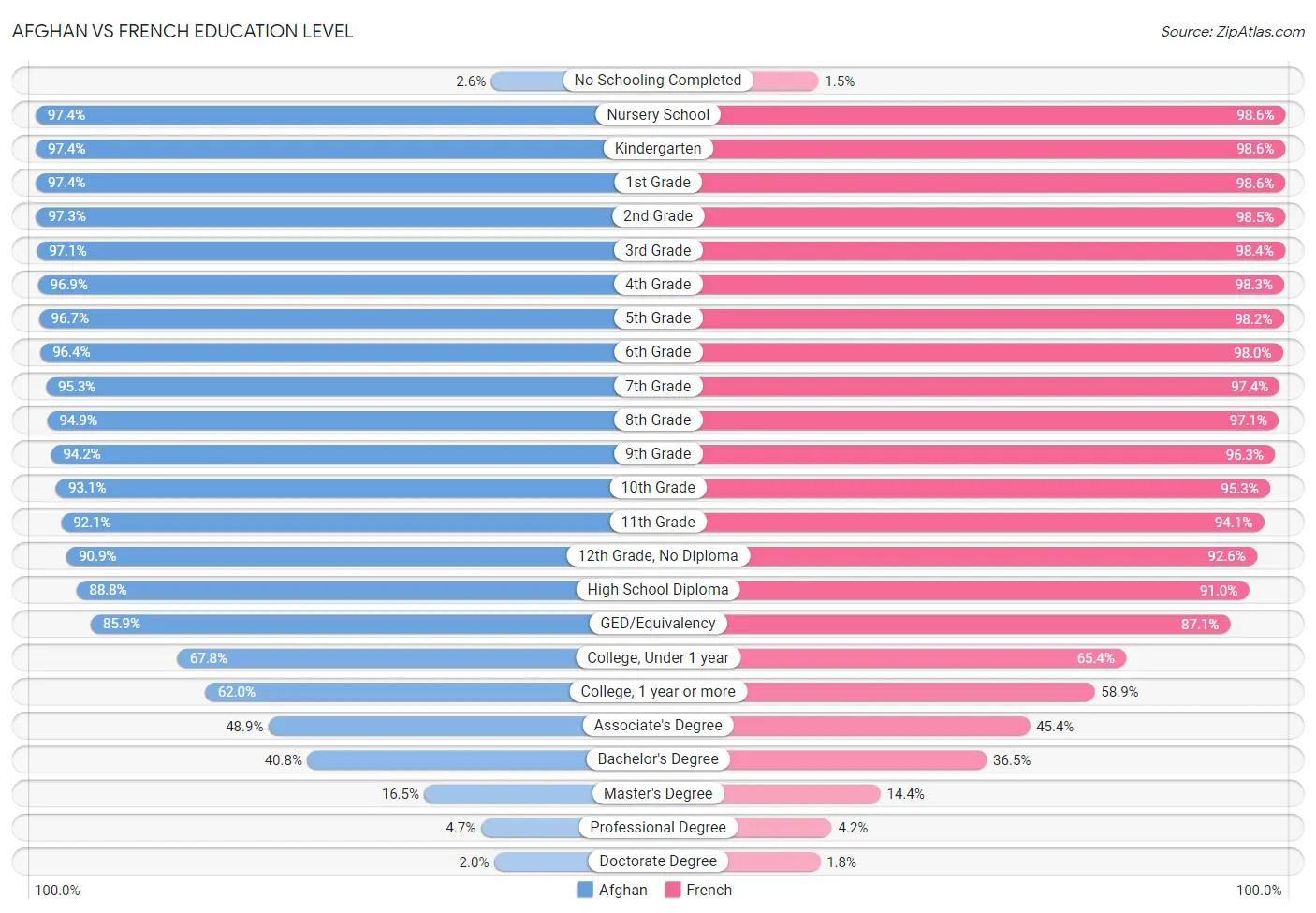
| Education Level Metric | Afghan | French |
| No Schooling Completed | Tragic 2.6% | Exceptional 1.5% |
| Nursery School | Tragic 97.4% | Exceptional 98.6% |
| Kindergarten | Tragic 97.4% | Exceptional 98.6% |
| 1st Grade | Tragic 97.4% | Exceptional 98.6% |
| 2nd Grade | Tragic 97.3% | Exceptional 98.5% |
| 3rd Grade | Tragic 97.1% | Exceptional 98.4% |
| 4th Grade | Tragic 96.9% | Exceptional 98.3% |
| 5th Grade | Tragic 96.7% | Exceptional 98.2% |
| 6th Grade | Tragic 96.4% | Exceptional 98.0% |
| 7th Grade | Tragic 95.3% | Exceptional 97.4% |
| 8th Grade | Tragic 94.9% | Exceptional 97.1% |
| 9th Grade | Tragic 94.2% | Exceptional 96.3% |
| 10th Grade | Tragic 93.1% | Exceptional 95.3% |
| 11th Grade | Poor 92.1% | Exceptional 94.1% |
| 12th Grade, No Diploma | Fair 90.9% | Exceptional 92.6% |
| High School Diploma | Fair 88.8% | Exceptional 91.0% |
| GED/Equivalency | Average 85.9% | Exceptional 87.1% |
| College, Under 1 year | Exceptional 67.8% | Average 65.4% |
| College, 1 year or more | Exceptional 62.0% | Fair 58.9% |
| Associate's Degree | Exceptional 48.9% | Fair 45.4% |
| Bachelor's Degree | Exceptional 40.8% | Poor 36.5% |
| Master's Degree | Exceptional 16.5% | Fair 14.4% |
| Professional Degree | Excellent 4.7% | Fair 4.2% |
| Doctorate Degree | Excellent 2.0% | Average 1.8% |
Afghan vs French Disability
When considering disability, the most significant differences between Afghan and French communities in the United States are seen in disability age under 5 (0.94% compared to 1.7%, a difference of 79.2%), hearing disability (2.7% compared to 3.8%, a difference of 37.3%), and disability age 18 to 34 (6.1% compared to 7.9%, a difference of 28.9%). Conversely, both communities are more comparable in terms of cognitive disability (17.3% compared to 17.0%, a difference of 1.9%), disability age over 75 (48.4% compared to 47.2%, a difference of 2.6%), and self-care disability (2.4% compared to 2.5%, a difference of 4.5%).
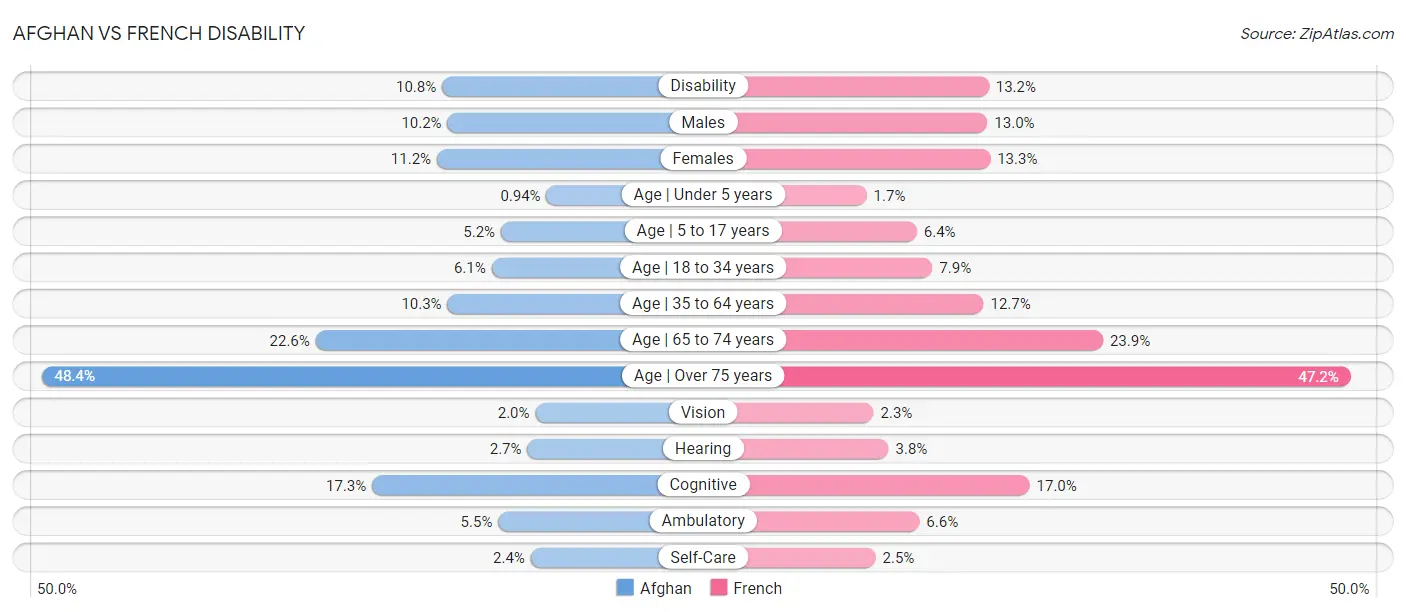
| Disability Metric | Afghan | French |
| Disability | Exceptional 10.8% | Tragic 13.2% |
| Males | Exceptional 10.2% | Tragic 13.0% |
| Females | Exceptional 11.2% | Tragic 13.3% |
| Age | Under 5 years | Exceptional 0.94% | Tragic 1.7% |
| Age | 5 to 17 years | Exceptional 5.2% | Tragic 6.4% |
| Age | 18 to 34 years | Exceptional 6.1% | Tragic 7.9% |
| Age | 35 to 64 years | Exceptional 10.3% | Tragic 12.7% |
| Age | 65 to 74 years | Excellent 22.6% | Poor 23.9% |
| Age | Over 75 years | Tragic 48.4% | Good 47.2% |
| Vision | Exceptional 2.0% | Tragic 2.3% |
| Hearing | Exceptional 2.7% | Tragic 3.8% |
| Cognitive | Fair 17.3% | Excellent 17.0% |
| Ambulatory | Exceptional 5.5% | Tragic 6.6% |
| Self-Care | Excellent 2.4% | Tragic 2.5% |